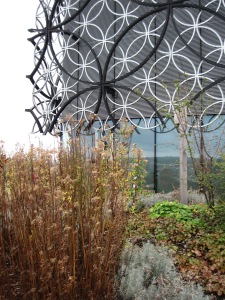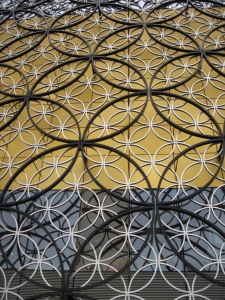In my last post I talked about the Social Media panel I attended at the Discovering Collections, Discovering Communities conference held in Birmingham (29-30th Oct). After a networking lunch where I mostly stood on the edge and talked to my friend (I had very blocked ears at this event and trying to hear people in a noisy room was really difficult), I went to the “Demonstrating the impact of collections” panel (5).
We all want impact, and we are all looking for ways to demonstrate our impact, especially to those higher up the food chain, so this seemed like a good panel to attend.
First up was Katie Giles talking about “Widening the Arc of friendship: exploring letters from Iris Murdoch and Phillipa Foot with the local community”. Kingston University’s Centre for Iris Murdoch Studies and Archives and Special Collections acquired over 200 letters from Murdoch to her friend and fellow philosopher Philippa Foot that covered a period of 40 years. The centre already had a large collection of letters and other items associated with Murdoch (such as her beer mat collection!), but decided to use this new acquisition in a community project, opening up the letters to non-academics and people who would never normally use their collections.
The letters arrived in a red canvas bag, in which they had been housed all along, and this red bag became a symbol for the project. The letters ranged from decorative airmail letters to postcards, and included a sketch ‘the dog of happiness’. They approached a variety of different groups within the local community, such as local schools, Age Concern Kingston, Carers, and Adults with Learning Difficulties in Kingston, and ended up with an age range of participants from 10 to 83 years old! They devised certain activities tailored to the participants, but ensured that all groups were given a visit to the archives. A particular challenge they overcame was working with adults with very low levels of literacy, but still successfully engaging them in a project centred round letters from a novelist.
Top tips learnt from the project:
1) Always talk to experts – different groups of people have different needs, so talk to the ‘experts’, the carers etc who normally work with these groups, and find out how best to engage with people. Don’t assume you know best!
2) Be adaptable and think on your feet.
3) Feel the fear and do it anyway!
Next up Kirsty Patrick (Mass Observation Archive, University of Sussex) talked about “Mass observation behind bars: building collections with the prisoner community”.
The Mass observation archive captures what every day life in Britain is like. The first round of investigations took place between 1937-1950s and involved volunteers sitting in pubs and cafes watching and taking notes about people, as well as a panel of volunteer writers who completed surveys. Newer material has been collected since 1981, although they no longer ask volunteers to ‘spy’ on people in public places! There is also the ‘12th May’ project – in 1937 Mass Observation called on people to keep a diary of everything they did that day (which was George VI’s Coronation day), this project has been repeated since 2010, and anyone can get involved.
At the archive they are trying to widen participation in this project and want to reach sections of society who would not normally get involved. Due to this they have reached out to community groups, disability charities and prisoners. In 2013 the Mass Observation project went behind bars at Lewes Prison, and took part in creative writing activities with prisoners. Those who contributed felt that they had been given a voice. Prison diaries were found to be very structured with strict timings due to the nature of life behind bars, but provided interesting insights to an aspect of everyday life in Britain not normally covered.
Both these two papers showed imaginative projects working with diverse sections of local communities and demonstrated that archives are not just for academics and specialists.
The final paper in this panel was “Valuing the archives: from non-market valuation to input-output analysis” presented by Lertchai Wasananikornkulchai (University of Glasgow) and based on research he is currently undertaking. I admit some of this did go over my head a bit as he discussed various economic models for demonstrating the value of archives. But a useful exercise in attempting to show that input-output analysis is a better model for smaller institutions and archives to use.




